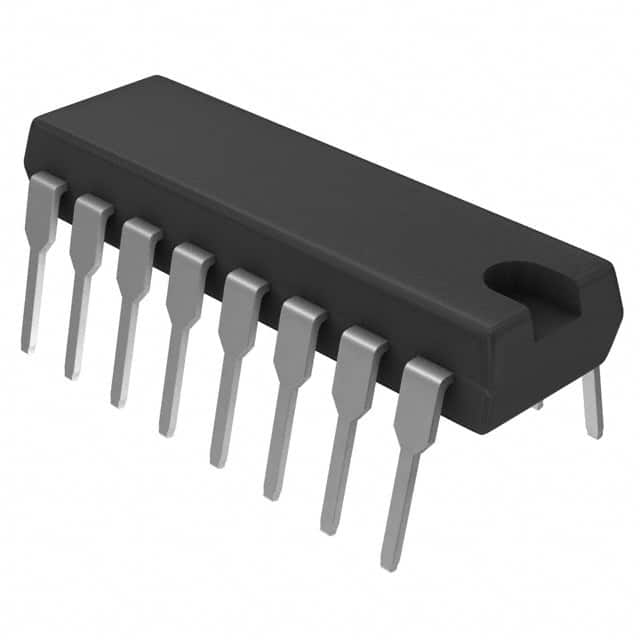Lihat spesifikasi untuk detail produk.

CD40147BEG4
Product Overview
Category
CD40147BEG4 belongs to the category of integrated circuits (ICs).
Use
This product is commonly used in electronic circuits for data encoding and decoding purposes.
Characteristics
- CD40147BEG4 is a high-performance, 10-line to 4-line priority encoder.
- It operates on a wide voltage range, typically from 3V to 18V.
- The device is designed to handle both TTL and CMOS logic levels.
- It offers low power consumption and high noise immunity.
- CD40147BEG4 is known for its fast response time and reliable performance.
Package
The CD40147BEG4 is available in a standard 16-pin DIP (Dual In-line Package) format.
Essence
The essence of CD40147BEG4 lies in its ability to encode multiple input lines into a smaller set of output lines based on their priority.
Packaging/Quantity
This product is typically sold in reels or tubes containing a quantity of 25 units per package.
Specifications
- Supply Voltage: 3V to 18V
- Input Lines: 10
- Output Lines: 4
- Logic Compatibility: TTL and CMOS
- Operating Temperature Range: -40°C to +85°C
- Package Type: 16-pin DIP
Detailed Pin Configuration
- A0 - Input Line 0
- A1 - Input Line 1
- A2 - Input Line 2
- A3 - Input Line 3
- A4 - Input Line 4
- A5 - Input Line 5
- A6 - Input Line 6
- A7 - Input Line 7
- A8 - Input Line 8
- A9 - Input Line 9
- GND - Ground
- E - Enable Input
- Y0 - Output Line 0
- Y1 - Output Line 1
- Y2 - Output Line 2
- Y3 - Output Line 3
Functional Features
- CD40147BEG4 prioritizes the input lines based on their significance and generates a binary code on the output lines.
- The device has an enable input (E) that allows or inhibits the encoding process.
- It provides a straightforward method for data encoding and decoding in various applications.
Advantages and Disadvantages
Advantages
- Wide operating voltage range makes it compatible with different systems.
- Low power consumption ensures energy efficiency.
- High noise immunity enhances reliability.
- Fast response time enables quick data processing.
Disadvantages
- Limited number of output lines may restrict its use in certain applications.
- Lack of built-in error detection or correction mechanisms.
Working Principles
CD40147BEG4 works on the principle of priority encoding. It assigns priority to each input line based on its position, with higher-positioned lines having higher priority. When multiple input lines are active simultaneously, only the highest-priority line is encoded and reflected on the output lines. The enable input (E) controls the encoding process, allowing or inhibiting the generation of the output code.
Detailed Application Field Plans
CD40147BEG4 finds application in various fields where data encoding and decoding are required. Some specific areas of application include:
- Communication Systems: Used for encoding and decoding data signals in communication protocols.
- Industrial Automation: Enables efficient data handling in control systems and PLCs.
- Automotive Electronics: Utilized in vehicle electronics for encoding sensor inputs and decoding control signals.
- Consumer Electronics: Integrated into devices like remote controls, keypads, and digital displays for data processing.
Detailed and Complete Alternative Models
- CD40147BE: Similar to CD40147BEG4, but without the "G4" suffix indicating RoHS compliance.
- CD74HC147E: A CMOS version of the priority encoder with similar functionality.
- CD4512BE: A 8-line to 3-line priority encoder, suitable for applications with fewer input lines.
These alternative models offer similar encoding capabilities and can be considered as substitutes for CD40147BEG4 based on specific requirements.
Word count: 515 words
Sebutkan 10 pertanyaan dan jawaban umum terkait penerapan CD40147BEG4 dalam solusi teknis
Sure! Here are 10 common questions and answers related to the application of CD40147BEG4 in technical solutions:
Q: What is CD40147BEG4? A: CD40147BEG4 is a BCD-to-7-segment latch/decoder/driver integrated circuit (IC) commonly used in digital display applications.
Q: What is the purpose of CD40147BEG4? A: CD40147BEG4 is used to convert binary-coded decimal (BCD) inputs into corresponding 7-segment display outputs, making it ideal for driving numeric displays.
Q: How many BCD inputs does CD40147BEG4 have? A: CD40147BEG4 has four BCD inputs (A, B, C, and D), allowing it to accept input values from 0 to 9.
Q: How many 7-segment outputs does CD40147BEG4 provide? A: CD40147BEG4 provides seven 7-segment outputs (a, b, c, d, e, f, and g) that can be used to drive a 7-segment display.
Q: Can CD40147BEG4 drive multiple 7-segment displays? A: Yes, CD40147BEG4 can drive multiple 7-segment displays by cascading multiple ICs together.
Q: What is the maximum frequency at which CD40147BEG4 can operate? A: CD40147BEG4 can operate at frequencies up to 6 MHz.
Q: Does CD40147BEG4 require external components for operation? A: Yes, CD40147BEG4 requires external resistors and capacitors for proper operation.
Q: Can CD40147BEG4 be used with both common anode and common cathode displays? A: Yes, CD40147BEG4 can be used with both common anode and common cathode 7-segment displays.
Q: What is the power supply voltage range for CD40147BEG4? A: CD40147BEG4 operates within a power supply voltage range of 3V to 18V.
Q: Is CD40147BEG4 suitable for battery-powered applications? A: Yes, CD40147BEG4 is suitable for battery-powered applications due to its low power consumption and wide operating voltage range.
Please note that these answers are general and may vary depending on the specific application and requirements.

